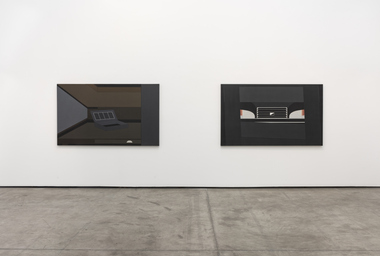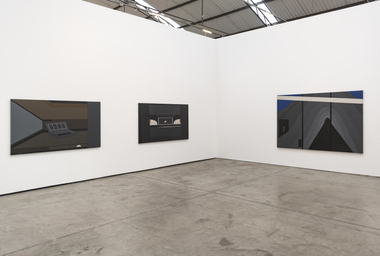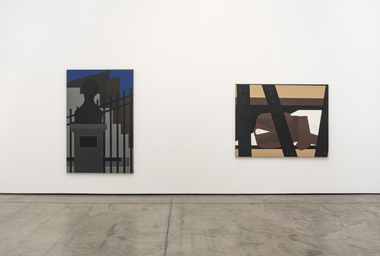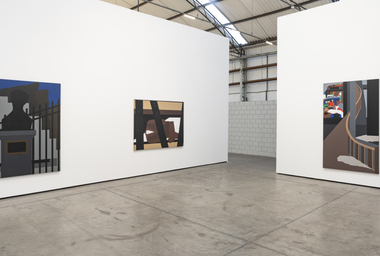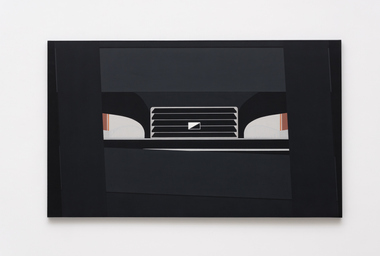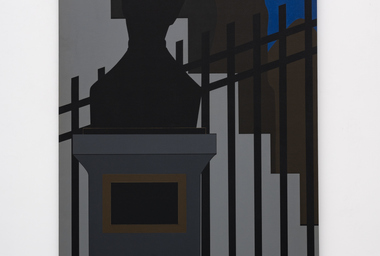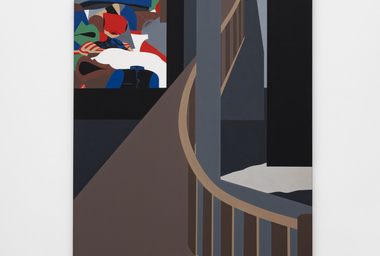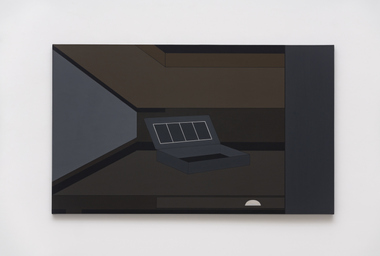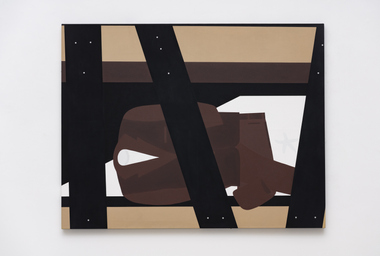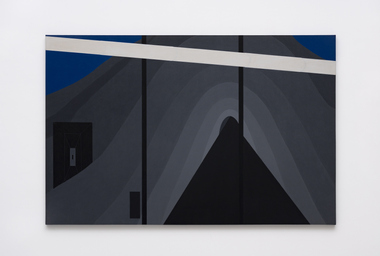
Wanda Pimentel
Wanda Pimentel: os anos noventa
May 7 – Jun 11, 2022
Opening
May 7, 2 pm–6 pm
FDAG Barra Funda
Download
Fortes D’Aloia & Gabriel is delighted to present an exhibition dedicated to the work of Wanda Pimentel (1943 – 2019), the first since she became a represented gallery artist. The six paintings selected for this show are from the 1990s, a period during which Pimentel refined her pictorial palette and use of figurative elements, dedicating herself to even stricter lines in dark compositions, prioritizing black, gray, blue, and brown. The boundary between the inside and the outside shifts in these gloomy environments that reinforce feelings of oppression and confinement, a central theme in the artist’s overall body of work.
Box Cover
By Evan Moffitt
What’s in a box? I am beguiled by one that Wanda Pimentel painted in 1994. It is empty and yet contains volumes. At the center of the canvas where its gray bottom should be, there is nothing but a void—perhaps a hole through the table below it. That support is also not what it seems: its edges appear mirrored on the ceiling above, as though the entire tableau were a stuttering film reel. Or, that could be a lid, another box enclosing this smaller one. There’s no telling where this all ends, or if there is even a world outside the limits of the painting.
Painting was Pimentel’s world for over fifty years, and one in which she imposed strict limits on herself. From the early 1960s, her canvases eschewed expressive gestures in favor of rigid geometries rendered in saturated acrylic tones. Their flat surfaces seem almost manufactured, as if subjected to the depersonalizing effects of modernization. And yet, if Pimentel sought to eliminate the mark of her own hand from her paintings, she invested them with as much depth of character as any contemporaneous work of “pop art.” She is everywhere in her depictions of domestic and urban life, often not as a hand but a pair of legs, which intrude on the scene from our own first-person perspective. Inviting us to see through the eyes of a woman both emancipated and alienated by consumerism, she shows us where the hard edges of late capitalist society admit windows onto private fantasy and introspection.
Leon Battista Alberti, writing in 1435, described painting as “an open window through which the subject…is seen.” Like a window – or, indeed, a box – a painting can permit us to move between two and three dimensions. It folds a flat, cropped view into a physical volume that holds our gaze. This operation mirrors the one by which Pimentel transformed her observations of immediate objects and environments into an incisive view of broad social and psychological conditions. Her work invites us to explore a phenomenology of open and closed, empty and full, solid and immaterial. The spaces around us and the spaces in our minds.
Pimentel was a 20-year-old bank secretary living in Botafogo, Rio de Janeiro in 1964 when she decided to enroll in Ivan Serpa’s class at the Museum of Modern Art. Serpa was a revered abstract painter who had come up with the hard-edged Neo- Concrete movement of the 1950s. If Serpa’s mentorship and the many long afternoons spent at the MAM canteen with Rubens Gerchman, Antonio Dias, and Cildo Meireles were an important influence on Pimentel, she quickly forged her own path. Within just two years, she would exhibit paintings in the 1966 National Salon of Modern Art that emblematized an emerging cultural shift towards colorful figuration. “Nova Figuração” (New Figuration) was a sardonic reaction to the new dictatorship, consumer culture, and patriarchal society, deploying flat, graphic aesthetics redolent of John Wesley, Tom Wesselmann, James Rosenquist, and Andy Warhol yet to far more politically radical ends. Pimentel, for her part, never paid much attention to American or British pop art, dismissing it as a celebration of the very consumerism she sought to critique. Her feminist pop would reject patriarchy in all its forms, including American economic, cultural, and military imperialism.
So began Pimentel’s “Envolvimento” series, paintings of domestic spaces on the brink of collapse. Tea kettles froth and blow dryers leap across the picture plane, as though in a state of open revolt against their owner. She appears to us only as a set of sheet-white legs, each foot extended in a position of indifferent repose, while these objects swarm her like Lilliputian soldiers. Although the fragmentation of her body and the intrusion of monstrously animate appliances increase the claustrophobia of these scenes, she doesn’t seem to take much notice. “Envolvimento”, or Involvement, might be more accurately understood as an “entanglement;” indeed, as Pimentel told Hans Ulrich Obrist in 2017, “the work is precisely about women being involved in the consumer society’s objects.” There’s an erotic relationship implied between this everywoman and the technology devised to domesticate her sex, but one in which she retains her right to withhold consent. No matter how confined we might feel looking at these paintings, Pimentel almost always offers us a means of resistance or escape.
Fitting, then, that in the 1970s she would shift her focus from enclosures to openings. The “Manhole” series, a rare experiment in sculpture, reproduced sewer grates that Pimentel encountered on her walks around Rio (predating the drains that made Robert Gober famous by nearly twenty years). There’s something lonely about the image of a manhole, which you only see while walking if you’re busy looking down at your feet. The works’ title, meanwhile, puns on bodily orifices blockaded by heterosexism. In these works, Pimentel claims the quintessentially male, bourgeois pastime of flaneurie for herself with penetrating wit.
A sense of trespass also characterizes Pimentel’s doors, which she began painting to scale on wooden panels in 1978. Much like the Manholes, they promise to open onto private interior spaces. Doors, like windows or box lids, are all apertures onto something that would otherwise be concealed from view. Pimentel thus frames the act of looking at art as an exercise of voyeurism. She invites us to look, holding the door half-ajar while jangling the keys.
In the early 1980s, Pimentel moved to an apartment in Lagoa, from which she could see the famous rocks of Rio: Dois Irmãos, Pedra da Gávea, and Morro do Cabrito. Her young daughter had just learned to crawl, then walk, and then run, taking over more of Pimentel’s living and working space. So she opened her windows and turned her gaze to the dramatic vistas of Guanabara Bay. The “Mountain” paintings which followed, though, are strange compressions of that majestic expanse with dark, moody skies of indigo or black. Axonometric lines slice across their geological formations, sometimes revealing striations of color, as if excavating layers of sedimentary rock. Pimentel’s 1986 depiction of Pedra da Gávea, for instance, looks less like a landscape than an x-ray.
These lines run through Pimentel’s paintings from the 1980s and ‘90s, recalling windowpanes or other architectural features. Most unsettling are her untitled tunnels of 1994: dark asphalt roads wedge their way into the lightless cavities of mountains, leading infinitely nowhere. Black rectangular frames, skewed at different angles, seem to afford us the impossible view from an apartment in the middle of a roadway. Other small black rectangles float incongruously on the picture plane, simultaneously denoting its flatness and the image’s depth. We could be staring down Túnel André Rebouças, near Pimentel’s home, or we could be staring into the abyss.
The discomfiting interiors of the “Envolvimento” paintings seem to imply that for emancipated women, the bourgeois household could not be a refuge. Yet Pimentel’s paintings of the world outside the home are just as alienating. Her tunnels and mountains position us on the other side of an architectural or geological enclosure, barriers we can never breach without fully losing ourselves. The “Monument” paintings, from this same period, envision those ubiquitous tools of state propaganda – statues on granite or concrete plinths – as shadows emptied of their historical content. In one untitled painting from 1994, the sculpture could be the bust of a man or a clenched fist. The plaque beneath him is as black and featureless as his silhouette. Behind him, a fence cuts us off from jagged gray steps (or perhaps a roofline) that mirror the cragged teeth of a mountain range. This is no friendly memorial but a razor-sharp premonition of danger. Pimentel completed the work nearly a decade after the fall of the dictatorship, but the pain of its enforced silences clearly remained with her. Perhaps anonymizing the totems of state violence was her way of reckoning with that trauma.
At the time, Pimentel had been fictionalized as the alcoholic heiress-turned-painter Heleninha Roitman in the telenovela Vale Tudo (1988-89). It’s unclear how much of the character was really inspired by her, but Pimentel’s paintings made cameos in the show, passed off as Heleninha’s own. She perhaps played into this stereotype of the tortured artist, saying in 1987, “I have never painted with joy. Everything I created was done in a painful way.” What must it have felt like to know that every household in Brazil had tiny “Envolvimentos” beamed into their living rooms on one of those televisions she regarded with such unease?
Yet it would be too neat to call Pimentel a Cassandra of late capitalism. Her work is too capacious to put in a box. Except, of course, one as expansive as only she could render, with no top or bottom, no inside or out, but rather a hole for us to move through. “To great dreamers of corners and holes nothing is ever empty,” as Gaston Bachelard observed. Pimentel was such a dreamer, an artist who created fullness in a society she often found spiritually empty. Hers is a box I’d like to live in.
